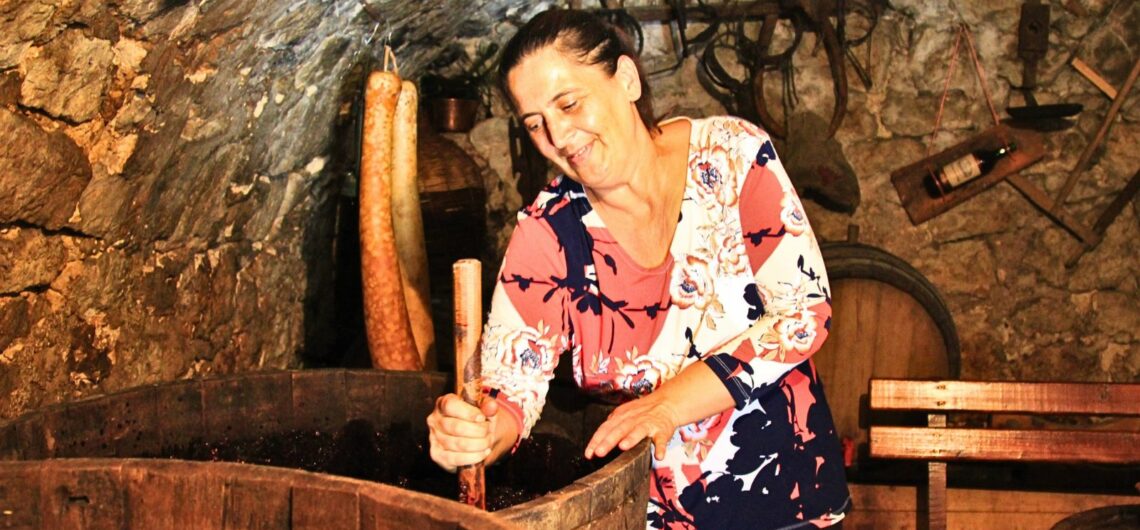Wait what? Balkan countries produce wine? Yes they do, as it happens, and some are not just good. They’re VERY good.
Wine season is fast approaching and we just so happen to have holiday bases in two of the finest wine countries in the Balkan region: Croatia and Montenegro. In late August and September, it’s busy on the vineyards as vintners begin harvesting, but they’ll always welcome visitors.
On both our week-long adventure near Dubrovnik in Croatia and our original crowd pleaser holiday at Villa Miela in Montenegro, we’re surrounded by family-owned vineyards which offer tours and tastings. If you’re joining us on a trip at this time of year, know that you’ll certainly get a chance to sample something grape.
Read on for a taste of Balkan wines.
Dingač Croatian wine
Croatia is best known for full bodied red varieties which grow mostly along the coast in Dalmatia, the most famous being Dingač. It’s found in the steep hilly subregion of the same name on the Pelješac peninsula in Southern Dalmatia.
Dingač is not a grape variety itself, it’s made from the Plavac Mali (‘little blue’) grape of Dalmatia. It was officially protected under Croatian law as a premium wine in 1965, but the tradition of winemaking in the Dingač region goes back centuries.
Likened to a Mediterranean wine, Dingač is big, fruity and tannic, so it’s a perfect pairing to those hearty meat dishes and strong cheeses.
On our week-long Croatia activity holiday, we have a sip and cycle day around the vineyards of Dingač. It’s a wonderful cultural experience with epic views of the vines against the backdrop of the Adriatic.
Subscribe to our monthly newsletter for travel inspiration and offers on holidays in the Balkans
Vranac & Krstač of Montenegro
Lake Skadar is Montenegro’s wine country with upwards of 30 commercial producers growing red, white and rosé wines.
Most common is the ruby red Vranac, Montenegro’s prized authochtonous grape and a relative of Primitivo and Zinfandel. Much like the Dingač of Croatia, these black-skinned fruits produce deep, full bodied reds with notes of cherry, chocolate and blackberry.
Montenegrins are also proud of their white Krstač, an ancient grape indigenous to Montenegro and Serbia. It produces high quality dry white wines which give French classics a run for their money. A sip of this liquid gold will fill your palette with hints of pear and ripe peaches, a great match for fish dishes.
If you’re joining us in Montenegro, we’ll take you on a wine-tasting tour to at least one of our favourite local wineries for sampling. Time your visit right, and you may even get involved with stirring the grapes yourself. It tastes all the better when sipped in the sunshine gazing out to the vines and distant Lake Skadar.

More on Balkan food and drink:
- How to drink Bosnian coffee the right way
- A recipe for burek… the traditional Balkan pastry with many names
- A recipe for Montenegrin priganice doughballs
Bosnian wine is one to watch
The southern city of Mostar in Bosnia and Herzegovina is surrounded by vineyards that have experienced a recent revival after production stopped during the 1990s conflicts. In 2024, it was named the ‘European Wine City Dionisio’ by the European Network of Wine Cities.
Though not typically known for its vino, south Bosnia enjoys a Mediterranean climate perfect for producing grapes such as white Žilavka and red Blatina and Trnjak. You can taste them straight from the barrel during a tour of one of many local wineries near the city.
A fun Balkan wine fact
In the Balkans, red wines are actually called ‘black wines’, or to translate ‘crno vino’ even more accurately, they are ‘dark wines’.
Looking for a more off-the-beaten-path wine experience? Join us for a week of mixed activities including wine tasting in Croatia or Montenegro


Comments